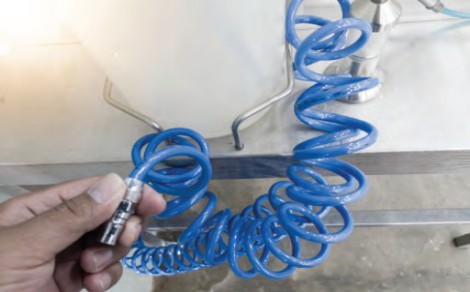- Home » Editorial » Pneumatics
Optimising pneumatic air lines for energy and efficiency

Pneumatic air lines are crucial yet often overlooked in compressed air systems. Effective design, installation, and maintenance reduce energy losses, prevent moisture damage, and ensure reliable performance. H&P explores practical solutions UK industries can adopt to optimise their air distribution networks and improve overall system efficiency
While the spotlight often falls on compressors and dryers, the network of pneumatic air lines that distribute the compressed air plays a pivotal role in the overall performance and efficiency of these systems. The pipes, tubing, and fittings form the backbone of compressed air delivery, and without careful attention to their design, installation, and maintenance, even the best compressors cannot ensure reliable, cost-effective operation.
One of the most significant challenges with pneumatic air lines is leakage. It’s easy to underestimate how much energy can be lost through small leaks, which often go unnoticed until maintenance teams conduct detailed inspections. In many industrial settings, leakages can amount to 20 to 30 per cent of the compressed air produced, a considerable waste both in terms of energy and cost. Locating these leaks by ear alone is no longer sufficient, and increasingly, ultrasonic leak detection technology is being adopted. These devices pick up the high-frequency sounds created by escaping air, allowing operators to identify and fix leaks promptly without disrupting production. Routine leak audits and a proactive maintenance regime are essential to controlling energy losses and maintaining system performance.
Choosing the right materials for pneumatic air lines is another fundamental consideration. Aluminium and stainless steel piping have become common choices in UK industries, prized for their durability and resistance to corrosion. Aluminium’s lightweight nature and compatibility with push-fit fittings make it an attractive option for many facilities, while stainless steel offers superior resistance where more demanding environments exist, such as chemical processing or food production. For smaller applications or where flexibility is a priority, plastic tubing like polyurethane or nylon provides ease of installation and adaptability. However, material selection must be coupled with good installation practices. Poorly supported pipes, incorrectly sized fittings, or inadequate routing can introduce stress points that lead to leaks or failure over time. Ensuring pipes are securely mounted, avoiding sharp bends, and planning logical, accessible routes can greatly extend system longevity.
Moisture accumulation inside air lines remains a persistent problem that can undermine pneumatic system integrity. Even with effective dryers at the source, changes in temperature or prolonged pipeline runs can lead to condensate forming within the pipes. This moisture can cause internal corrosion, damage pneumatic tools, and compromise product quality—particularly in sensitive sectors like pharmaceuticals, food and beverage, and electronics manufacturing, where air purity is paramount. To manage condensation, it’s important to incorporate drainage points and condensate traps at strategic locations within the air line network. Designing pipelines with slight gradients towards these drains can encourage water to flow naturally out of the system. In some cases, especially where temperature fluctuations are marked, insulating or heating sections of piping helps reduce condensate formation, protecting the system and maintaining air quality.
-
PPMA 2025
23 September, 2025, 9:30 - 25 September, 2025, 16:00
NEC, Birmingham UK -
Advanced Engineering Show 2025
29 October, 2025, 9:00 - 30 October, 2025, 16:00
NEC, Birmingham UK










